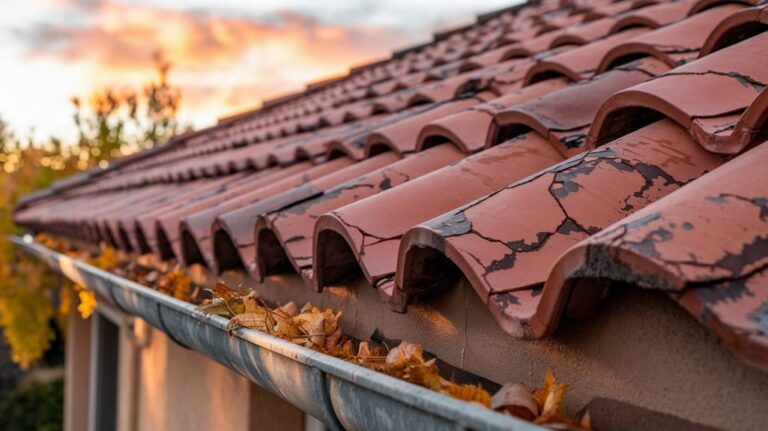Prioritize your safety as the top concern while working on roofing projects. Utilize safety harnesses for fall prevention and secure ladders properly. Stay weather-aware and clear the work area for a safer environment. Wear slip-resistant footwear and follow ladder safety guidelines. Working with a buddy enhances safety and effective communication is key. Take regular breaks and be prepared for emergencies. These essential roofing safety tips will help you stay safe while working.
Importance of Roofing Safety
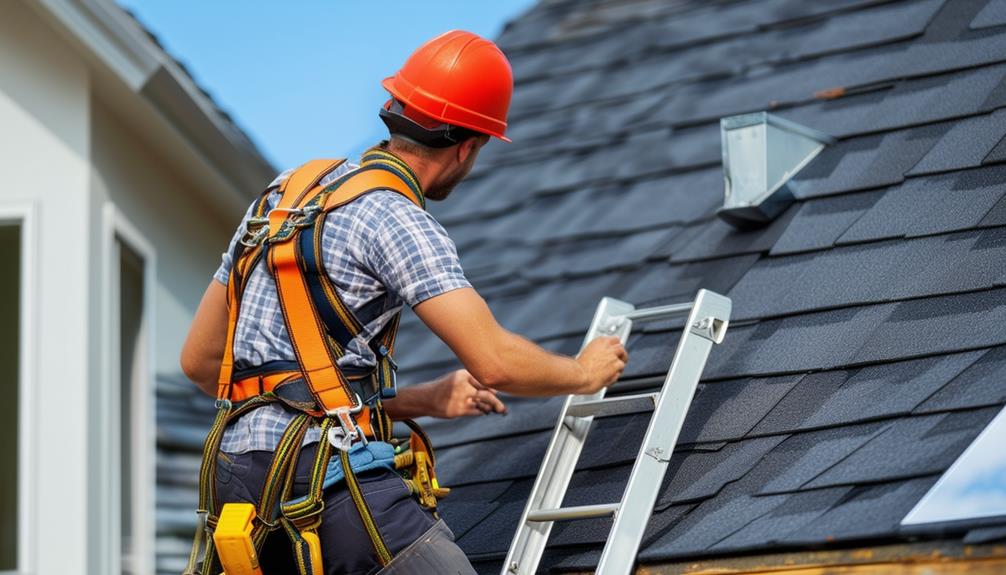
Ensuring roofing safety is important to prevent accidents and injuries while working at heights. Safety protocols play a key role in safeguarding workers from potential hazards. By implementing strict safety measures, you can greatly reduce the risk of accidents on the job.
Preventing accidents should be a top priority when working on roofs. Establishing clear safety protocols, such as using fall protection gear, securing ladders properly, and conducting regular site inspections, can help minimize the chances of mishaps. It is essential to follow industry guidelines and regulations to create a safe working environment. Employers and workers should prioritize training programs to ensure everyone is knowledgeable about potential hazards and the correct use of equipment. Adhering to OSHA roofing safety standards not only helps prevent accidents but also ensures compliance with legal requirements, protecting both employees and businesses. By fostering a culture of safety and vigilance, teams can effectively reduce risks associated with roofing work.
Regular safety training is essential to preventing accidents. Ensuring that all workers are well-versed in safety procedures and protocols can help mitigate risks. By educating employees on best practices and potential dangers, you empower them to make informed decisions that prioritize their safety.
Proper Equipment Usage
Utilize appropriate safety equipment when working on roofs to minimize risks and establish a secure work environment. Safety harnesses are essential for preventing falls and guaranteeing your protection while working at heights. When using safety harnesses, make sure they are properly fitted and securely anchored to a stable structure. Inspect the harness for any signs of wear and tear before each use to confirm its reliability.
Fall protection is another critical aspect of proper equipment usage. Install guardrails, safety nets, or personal fall arrest systems to safeguard against potential falls. Ensure that these fall protection measures meet industry standards and are correctly installed. Regularly inspect and maintain fall protection equipment to confirm its effectiveness and reliability.
Weather Awareness
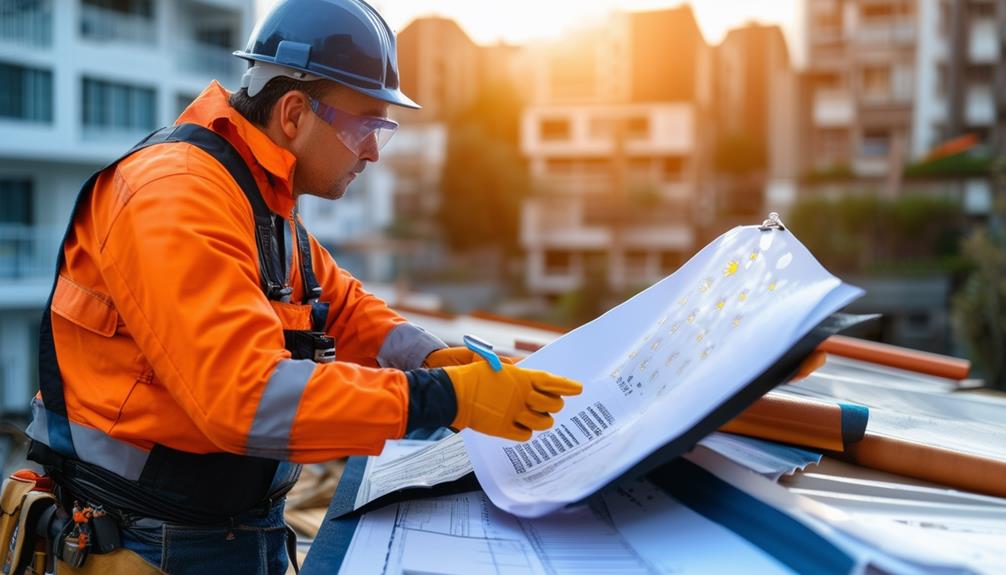
Stay vigilant of changing weather conditions to guarantee the safety of yourself and your team while working on roofs. Proper attire and adherence to safety protocols are essential in ensuring you are prepared for any weather challenges. When working on roofs, always wear appropriate clothing such as non-slip footwear, gloves, and clothing that protects you from both the sun and potential rain. In hot weather, stay hydrated and take regular breaks in shaded areas to prevent heat-related illnesses. During windy conditions, secure loose items to prevent them from becoming hazards. If thunderstorms are forecasted, it is best to postpone work to avoid the risk of lightning strikes. Remember, your safety and the safety of your team come first, so always prioritize weather awareness and take necessary precautions to prevent accidents or injuries. By staying alert and prepared, you can ensure a safe and productive roofing experience.
Clearing the Work Area
Before starting any roofing work, remember to clear debris from the roof surface. Inspect the area for any potential hazards that could cause accidents. Make sure to secure all tools properly to prevent them from falling and causing injuries.
Clear Debris From Roof
Clearing debris from the roof is essential to establish a safe work area before starting any roofing activities. Debris removal is vital as it can pose tripping hazards, cause tools to slip, or even lead to accidents involving falling objects. To guarantee safety, start by removing any loose materials such as leaves, branches, or old roofing materials from the roof surface. Use a sturdy rake or broom to clear the area thoroughly, paying attention to corners and edges where debris tends to accumulate.
Safety precautions must be observed during debris removal to prevent injuries. Wear appropriate personal protective equipment, including gloves and eye protection, to shield yourself from sharp objects or dust. Be cautious when moving debris to avoid overloading yourself and maintain balance while on the roof. By clearing the roof of debris before commencing work, you create a safer environment for yourself and your team, reducing the risk of accidents and ensuring a smoother roofing process.
Inspect for Hazards
Inspect the work area for potential hazards to guarantee a safe roofing environment. Identifying risks before starting work is vital to prevent accidents. Look out for loose debris, like shingles or nails, that could cause slips or falls. Check for overhead power lines and make sure you are a safe distance away. Clear any obstacles that could impede your movement while working on the roof. Hazard prevention starts with a thorough inspection of the surroundings.
Regularly assess the roof for weak spots or areas that might not support your weight. Address any issues before beginning work to avoid accidents. Keep an eye out for unstable ladders or unstable surfaces that could lead to falls. Ensuring a hazard-free work area is crucial for your safety and the safety of those around you.
Secure Tools Properly
Guarantee all tools are securely stored and organized in their designated places to maintain a clutter-free and safe work area. Proper tool organization is vital in preventing accidents and ensuring efficiency. Make sure to secure all tools when not in use to prevent them from falling off the roof or causing tripping hazards. Utilize tool belts or boxes to keep small tools within reach and safely stored. Additionally, always wear a safety harness when working at heights to secure yourself and prevent falls.
Regular equipment maintenance is essential to ensure tools are in good working condition. Check tools for any defects or damages before each use, and promptly repair or replace any faulty equipment. Proper tool storage is also important to maintain a safe work environment. Store tools in designated areas after use to prevent clutter and potential hazards. By following these practices, you can create a secure work area and minimize the risk of accidents while working on a roof.
Proper Footwear
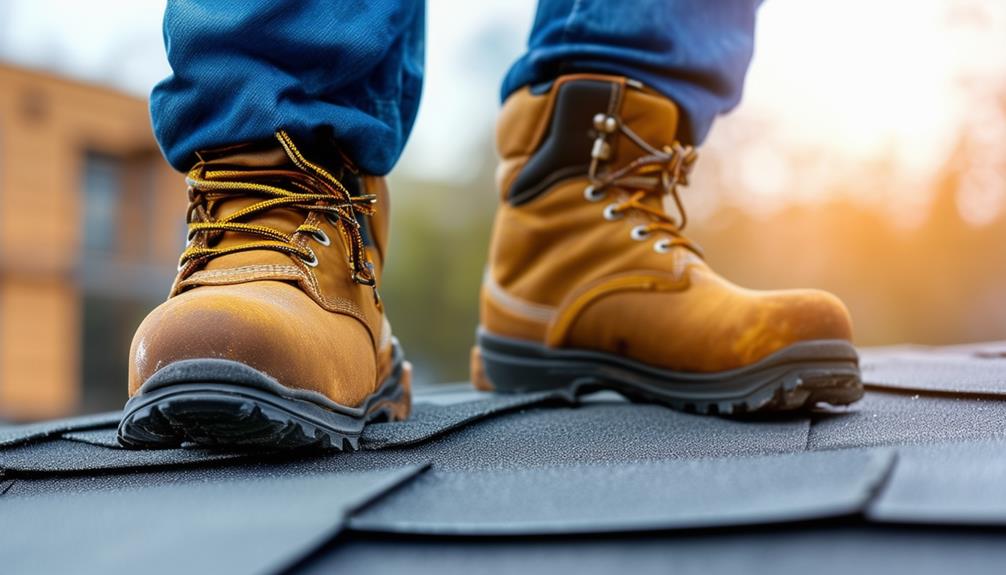
Wearing sturdy, slip-resistant shoes is vital when working on a roof to prevent accidents and maintain stability. When selecting footwear for roofing projects, opt for shoes with good ankle support to reduce the risk of twisting or spraining your ankle on uneven surfaces. Safety precautions include choosing shoes with thick, durable soles to protect your feet from sharp objects and providing traction to prevent slipping. It's important to make sure that the shoes fit well and are securely fastened to your feet to avoid tripping hazards while working on the roof.
Proper footwear also involves avoiding open-toed shoes or sandals, as they do not provide ample protection for your feet in a roofing environment. Steel-toed boots are a great option for added protection against heavy objects that could fall on your feet. Remember, the right footwear not only keeps you safe but also enhances your overall stability and comfort while working at heights.
Ladder Safety
When working on a roof, your safety also heavily depends on how you handle ladders. Proper ladder safety is vital to prevent accidents and guarantee a smooth roofing process. Here are some essential tips to keep in mind:
- Ladder Maintenance: Before each use, check your ladder for any signs of damage or wear. Make sure all parts are in good condition, such as the rungs and side rails.
- Ladder Placement: Position your ladder on a firm and level surface. Avoid placing it on uneven ground or slippery surfaces. Additionally, the base of the ladder should be secured to prevent any movement while climbing.
- Ladder Weight Limit and Stability: Always adhere to the weight limit specified by the ladder's manufacturer. Overloading a ladder can lead to instability and potential accidents. Ensure the ladder is stable before climbing by using the 4-to-1 rule: for every 4 feet of height, move the base of the ladder 1 foot away from the wall.
Following these ladder safety tips will greatly reduce the risks associated with working at heights.
Working With a Buddy
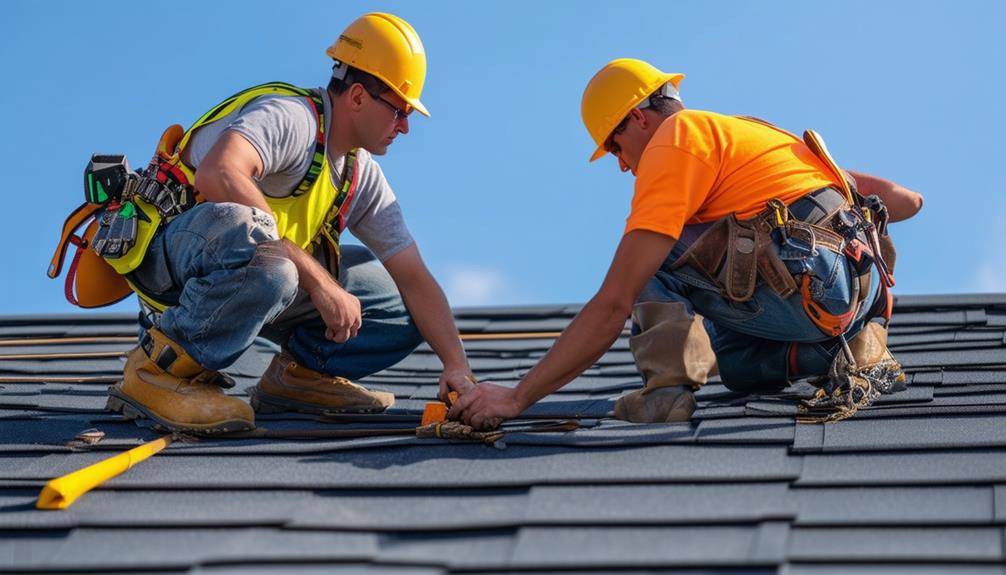
When working on a roof, having a buddy can make a big difference in your safety. The buddy system provides an extra set of eyes and hands to help prevent accidents. Communication between you and your buddy is crucial to guarantee a smooth and safe roofing job.
Buddy System Benefits
To enhance safety on the job, consider the benefits of working with a buddy while roofing.
- Essential Benefits: Working with a buddy promotes collaboration, allowing for tasks to be completed more efficiently and effectively.
- Support System: Having a buddy provides an extra layer of support, both physically and mentally, reducing the risk of accidents or injuries.
- Risk Management: With a buddy by your side, you have someone to help identify potential hazards, offer solutions, and guarantee safety protocols are followed.
Roofing can be a hazardous job, and having a buddy can greatly improve safety measures. Teamwork benefits extend beyond just getting the job done; it enhances overall safety. A buddy system serves as a support system, boosting morale and creating a safer working environment. Effective risk management is vital in roofing, and working with a buddy allows for better risk assessment and mitigation. Remember, when it comes to roofing safety, two sets of eyes and hands are better than one.
Communication Is Key
Working with a buddy while roofing emphasizes the importance of clear and effective communication for ensuring safety and efficiency on the job. Team communication and following safety protocols are critical when working at heights. Clear instructions should be given and understood before starting any task. Quick responses to any potential hazards or emergencies are important in preventing accidents. Make sure to establish a system of signals or calls to communicate effectively with your partner, especially in noisy environments.
Prioritize safety by regularly checking in with each other and confirming that safety equipment is properly worn and functioning. Work together to anticipate each other's movements and needs to prevent accidents and increase productivity. It's crucial to have a plan in place for emergencies, such as how to handle a slip or fall. By maintaining open and clear communication, you and your buddy can create a safe and efficient roofing work environment.
Regular Breaks
Taking regular breaks during roofing work is essential for maintaining focus and preventing fatigue. Here are some key tips to help you stay safe and productive:
- Hydration Breaks: Remember to drink water regularly to stay hydrated, especially on hot days when working on the roof. Dehydration can lead to decreased concentration and performance.
- Stretching Exercises: Incorporate simple stretching exercises into your break routine to prevent muscle strain and improve flexibility. Focus on areas like your back, shoulders, and legs to counteract the physical demands of roofing work.
- Mental Breaks and Eye Protection: Take short mental breaks to rest your mind and prevent burnout. Additionally, always wear proper eye protection to shield your eyes from debris, harmful UV rays, and potential accidents.
Emergency Preparedness
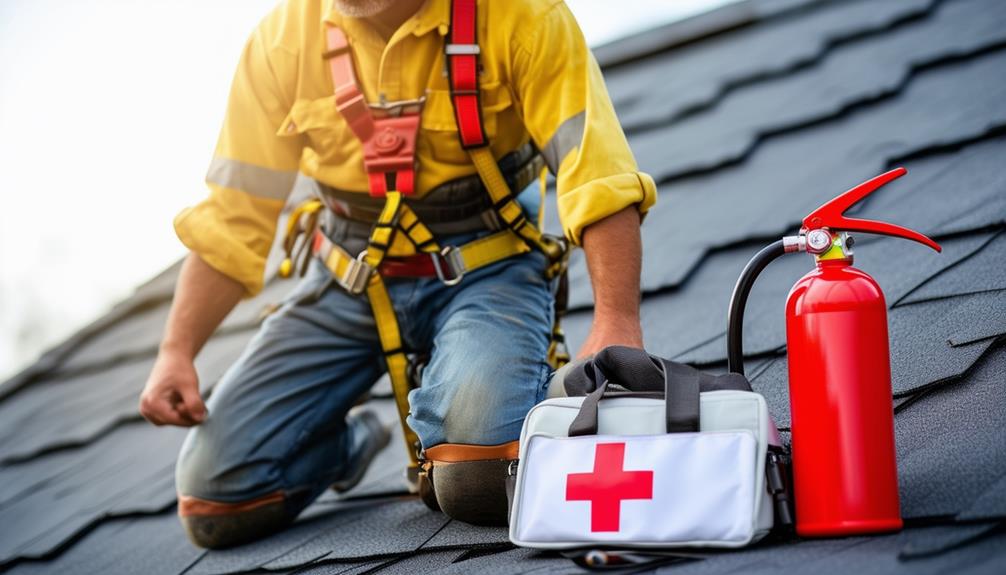
Make sure you have a well-stocked first aid kit readily accessible at the work site for any unforeseen emergencies during roofing projects. In addition to having essential medical supplies on hand, it is important that all workers undergo first aid training to address injuries promptly and effectively. Being prepared for emergencies also involves establishing clear emergency response protocols. Conducting safety drills regularly can help familiarize all team members with proper evacuation procedures and emergency measures to follow in case of accidents or disasters.
First aid training equips employees with the necessary skills to provide immediate assistance until professional help arrives, potentially saving lives in critical situations. Familiarity with emergency response procedures ensures a coordinated and efficient reaction in times of crisis, reducing the risk of further harm. By prioritizing emergency preparedness through first aid training, safety drills, and evacuation procedures, roofing workers can mitigate risks and enhance overall safety on the job site.
Frequently Asked Questions
Can I Use My Regular Work Gloves for Roofing?
You shouldn't use regular work gloves for roofing. When it comes to glove selection, opt for specialized roofing gloves that provide better grip and protection. As for safety harness maintenance, always inspect and maintain your harness regularly to make sure it's in good condition. Your safety is paramount, so investing in the right gear like roofing gloves and properly maintaining safety equipment like harnesses is vital for a safe roofing experience.
How Often Should I Replace My Safety Harness?
You should replace your safety harness every five years to make sure it remains reliable. Regularly inspect the harness for wear and tear, paying close attention to the straps, buckles, and D-rings. Proper equipment maintenance is essential for safety, so adhere to manufacturer guidelines for lifespan and inspection techniques. Stay proactive about safety protocols to protect yourself while working at heights.
Is It Safe to Work on a Roof During High Winds?
Working on a roof during high winds is extremely important. The strong gusts can make it difficult to maintain balance and control. Your roofing equipment may be affected, increasing safety concerns. It is essential to take weather precautions before starting any work on the roof. Make sure that work conditions are safe and stable to avoid accidents and injuries. Prioritize your safety above all else when working in challenging weather conditions.
Do I Need to Clear the Roof of Debris Before Starting Work?
Before diving into your roofing project, envision your workspace as a clean canvas ready for your masterpiece. It's essential to clear the roof of debris before starting work. Removing debris not only enhances the aesthetics but also safeguards against potential safety concerns. Prioritize debris removal to prevent injury and guarantee a smooth roofing material application process. Stay proactive in maintaining a clean work environment for a successful and safe roofing experience.
Should I Wear Steel-Toed Boots on a Roof?
You should definitely wear steel-toed boots on a roof. Proper footwear like steel-toed boots provides essential protection for your feet in case of accidental impacts. Safety gloves are also important for hand protection. Additionally, using a roofing harness is recommended for fall prevention. Check wind conditions before starting work to guarantee safety. Prioritize your safety by following these guidelines for a secure roofing experience.
Conclusion
To sum up, remember to always prioritize safety when working on a roof. By following these roofing safety tips, you can guarantee a successful and injury-free project. But, always keep in mind, accidents can happen when you least expect them, so stay vigilant and prepared. Stay tuned and stay safe!



